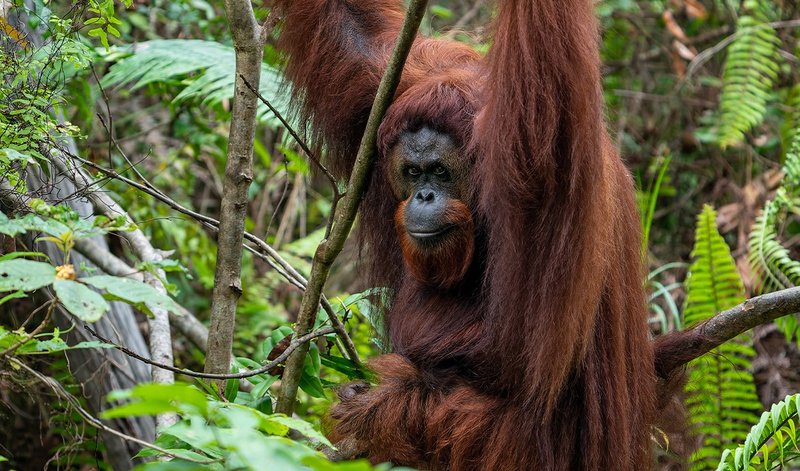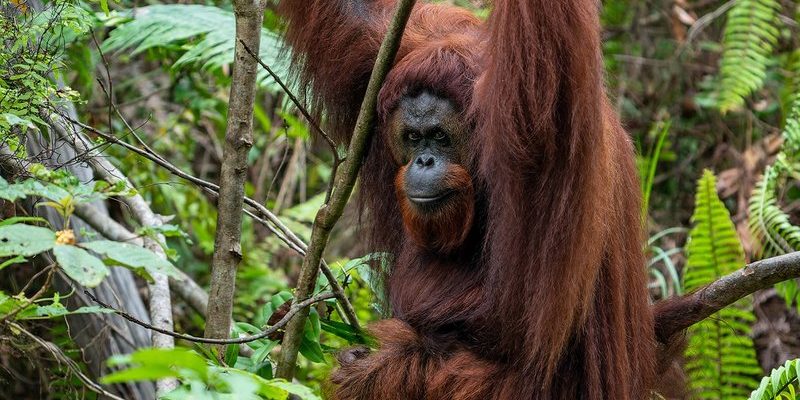
Imagine Borneo as a vibrant, green canvas painted with thick forests, towering trees, and winding rivers. This island is part of Indonesia, and it’s one of the last remaining strongholds for these critically endangered orangutans. Their home isn’t just a random patch of forest. It’s a complex ecosystem that provides everything they need to thrive. So, grab a cup of coffee, and let’s unravel the story of where Bornean orangutans live.
Understanding Borneo’s Tropical Rainforest
To truly appreciate where Bornean orangutans live, we need to understand their habitat. Borneo is home to some of the oldest tropical rainforests in the world, teeming with life. These dense forests are characterized by rich biodiversity, meaning you’ll find various plants, animals, and insects all coexisting together.
The trees in these forests can reach soaring heights, some standing over 200 feet tall! The dense canopy formed by these trees creates a perfect home for orangutans. Here, they find ample food sources, including fruits, leaves, and flowers. It’s like a buffet up in the treetops! You might be wondering why they don’t just settle anywhere else. Well, the unique layers of the rainforest provide the shelter and food they need, making it the ideal living space.
Unfortunately, this lush paradise is facing threats from deforestation and habitat destruction. As more trees are cut down for palm oil plantations or logging, the orangutans are losing their homes. This loss doesn’t just mean fewer trees; it impacts the entire ecosystem that relies on this habitat to function.
The Distribution of Bornean Orangutans
Bornean orangutans are native to the island of Borneo, which is divided into three countries: Indonesia, Malaysia, and Brunei. However, their range is mainly localized in the northern and central parts of the island. They primarily inhabit areas of lowland tropical rainforests, but you can also find them in mountainous regions and peat swamp forests.
Here’s the thing: these orangutans have different habitats depending on where they live on the island. In the lower elevations, they thrive in lowland rainforests, where food is abundant. In contrast, in the misty mountains, they adapt to a cooler climate with different types of vegetation. It’s fascinating how they’ve evolved to make the most out of their surroundings, right?
Their populations are scattered across Borneo, so seeing one in the wild is becoming increasingly rare. While there are conservation efforts in place to protect these incredible creatures, their distributions are still becoming more limited. This makes understanding where they live even more critical.
Food Sources and Feeding Habits
Bornean orangutans are classified as frugivores, which means they love fruit! Their diet consists primarily of *fruits*, but it also includes leaves, wood, and insects. Some of their favorites are durian, figs, and other tropical fruits found in the canopy. Think of it as their version of a colorful, healthy salad!
They are also known for their intelligence. When searching for food, orangutans demonstrate remarkable problem-solving skills. They often use tools, like sticks, to extract insects or reach fruits. Have you ever tried to grab an unreachable snack? It’s kind of like that!
Their feeding habits play a crucial role in the ecosystem, too. As they munch on fruits, they help disperse seeds throughout the forest, aiding in plant growth. This relationship helps maintain the biodiversity that defines their home. It’s a beautiful reminder of how interconnected everything is in nature!
Threats to Their Habitat
While it’s wonderful to think about how Bornean orangutans thrive in their forests, we can’t ignore the serious threats facing their habitat. Deforestation is the primary culprit. As companies clear vast areas for agricultural purposes, especially palm oil production, animals like orangutans find it increasingly difficult to survive.
Imagine being forced to leave your cozy home because your favorite hangout spot is being turned into a parking lot—it’s a grim picture! Additionally, logging activities strip away the very trees that provide shelter and food. With less space and resources, orangutan populations continue to dwindle, making every day a struggle for survival.
Pollution is another concern. The rivers that meander through their habitat can become contaminated, affecting their health and the health of the forest itself. Without clean water and a stable environment, the intricate balance of their ecosystem is at risk.
Conservation Efforts for Bornean Orangutans
Given the challenges facing Bornean orangutans, various conservation efforts have started to take root. Organizations worldwide are working tirelessly to protect their habitats and educate people about the importance of these incredible animals.
One successful approach is the establishment of protected areas, where logging and agricultural practices are restricted, allowing orangutans to thrive. Reforestation projects are also underway, where trees are planted to restore damaged areas of the forest. It’s like giving nature a helping hand to rebuild what’s been lost.
Additionally, many programs focus on educating local communities about the significance of biodiversity and sustainable practices. By informing people about how their actions impact these animals, we can foster a sense of responsibility and connection to this beautiful ecosystem.
Visiting the Habitat of Bornean Orangutans
If you’re ever thinking about visiting Borneo to see these magnificent creatures, it can be a life-changing experience. Numerous eco-tourism initiatives allow you to witness orangutans in their natural habitat without disturbing them. It’s like stepping into a living storybook!
Travelers often head to places like the Sepilok Orangutan Rehabilitation Centre, where you can observe these animals up close and learn about conservation efforts. These experiences not only create unforgettable memories but also contribute to the local economy and encourage the preservation of the environment.
Remember, when you visit, tread lightly and respect the space of the wildlife. After all, we’re guests in their home, and it’s essential to keep their habitat safe and intact.
The Importance of Bornean Orangutans in Their Ecosystem
Bornean orangutans aren’t just cute creatures swinging through the trees; they play a vital role in their ecosystem. As seed dispersers, they help maintain the health and diversity of the rainforest. This function helps support the entire habitat, ensuring it remains a thriving environment for various species.
Moreover, their presence is an indicator of the overall health of the rainforest. If orangutan populations decline, it’s a sign that the ecosystem is struggling. Protecting them ultimately helps safeguard the intricate web of life that relies on the forest.
As we navigate our lives, it’s easy to forget how interconnected everything is. By understanding where Bornean orangutans live—and the challenges they face—we can start to see the broader picture of conservation. It’s not just about saving another species; it’s about protecting the delicate balance of our planet.
In conclusion, the habitat and distribution of Bornean orangutans are vital to their survival and the wellbeing of their ecosystem. From their lush forest homes to the food sources that sustain them, every aspect of their lives is worth protecting. So, next time you think of these incredible creatures, remember their story and the importance of their home. Together, we can help ensure that future generations get to enjoy the beauty of Bornean orangutans in their natural habitat.

